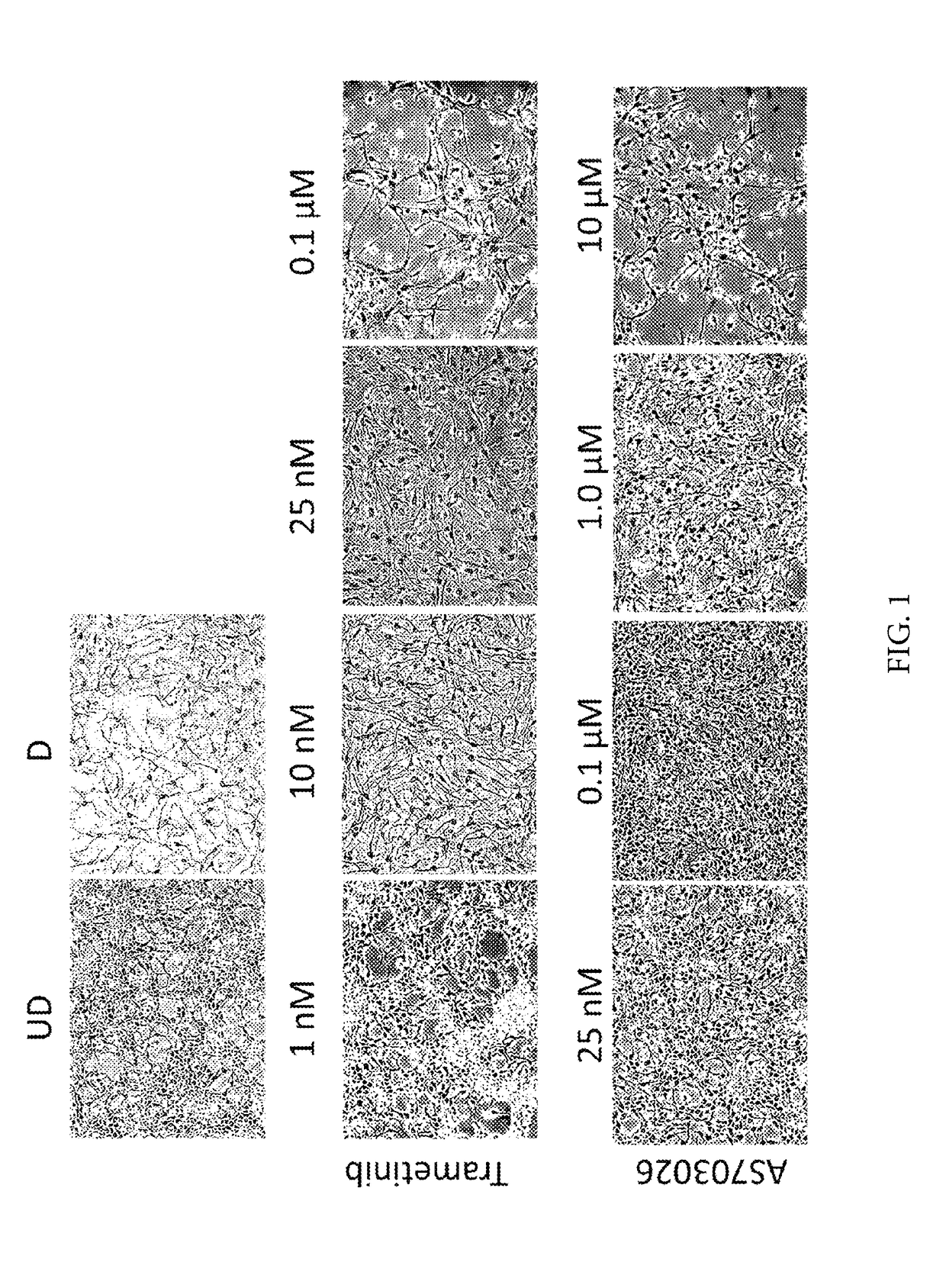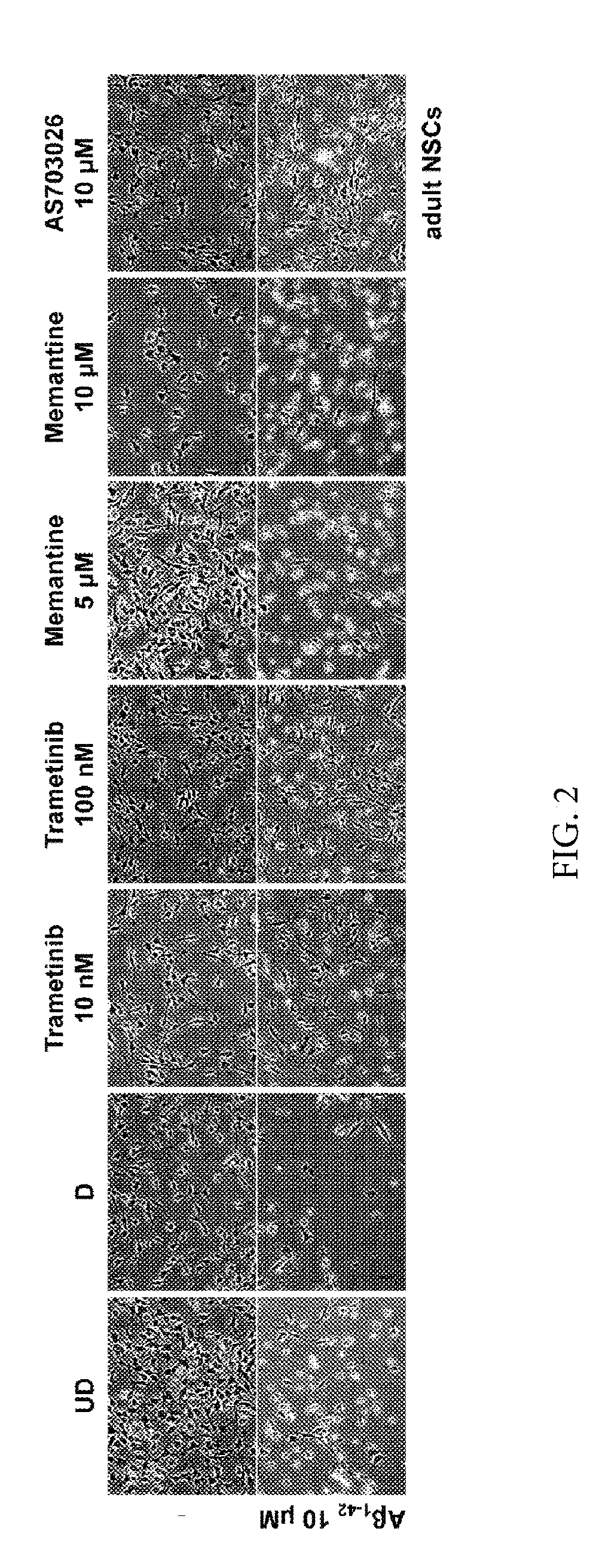Composition for Inducing Differentiation and Protection of Neural Stem Cells and Method for Inducing Neuro-Regeneration Using the Same Composition
- Summary
- Abstract
- Description
- Claims
- Application Information
AI Technical Summary
Benefits of technology
Problems solved by technology
Method used
Image
Examples
example 1
ifferentiation-Inducing Ability of the Compound of [Formula 1] in Mouse Embryonic Neural Stem Cells
[0131]Step 1: Culturing mouse embryonic neural stem cells
[0132]Step 1A: Culturing mouse embryonic neural stem cells in the undifferentiated state
[0133]Neural stem cells were isolated from the brain of a day 14.5 mouse embryo, treated with 10 ng / ml human basic fibroblast growth factor (bFGF) (Peprotech, Princeton, NG, cat#0.100-18B) and 20 ng / ml human epidermal growth factor (EGF) (Peprotech, cat#. AF-100-15) in a N2 culture medium, and cultured in suspension in a 25 cm2 flask (Nunc, Pittsburgh, Pa.) for 4 days. Formation of neurospheres was observed after 2 days.
[0134]In order to isolate single cells, 6-well plates were prepared the day before by treating the wells with 15 μg / ml poly-L-ornithine (Sigma, St. Louis, Mo., cat#.P2533) solution and incubating overnight at 37° C. for coating. The day of the single cell isolation, poly-L-ornithine solution was removed, the plates were washed ...
example 2
ifferentiation-Inducing Ability of the Compound of [Formula 1] in Mouse Adult NSC (Method of Screening for Substances that can Induce the Differentiation of NSC into Neurons while Protecting them at the Same Time)
[0146]Step 1: Culturing mouse adult NSC
[0147]Step 1A: Culturing mouse adult NSC in the undifferentiated state
[0148]NSC were isolated from the subventricular zone of week 8 mouse brain, treated with 20 ng / ml human basic fibroblast growth factor (bFGF) and 20 ng / ml human epidermal growth factor (EGF) in an IPM medium, and cultured as a suspension in 24-well plates for 7 days. The formation of neurospheres was observed after 4 days.
[0149]Two days before the isolation of single cells, 6-well plates were prepared by treating the wells with 10 μg / ml poly-L-ornithine solution and incubating overnight at room temperature for coating. The next day, poly-L-ornithine solution was removed and the plates were washed 3 times with sterilized triple distilled water. Next, 0.5 mg / ml laminin...
example 3
ochemistry Analysis
[0174]In order to reconfirm the differentiation of NSC into neurons in Example 1, immunocytochemical staining of Tuj1 and DAPI (4′,6-diamidino-2-phenylindole) markers was performed. Tuj1 (Neuron specific class III beta-tubulin) is a neuron specific marker protein, which was conjugated to rhodamine to show fluorescent red, while DAPI binds to the cell DNA and stains the cell nuclei fluorescent blue.
[0175]Embryonic NSCs cultured as described in Example 1 were seeded into 24-well plates with coverslips and treated with trametinib and AS703026 in the respective concentrations for 4 consecutive days. The medium was removed and the cells were washed with PBS. After fixing with 10% formaldehyde (Sigma cat#. HT501128) at room temperature for 10 minutes, they were washed again with PBS. They were permeabilized with 0.2% Triton X-100 (Sigma, cat#. 93443) at room temperature for 15 minutes, washed with PBS, and incubated with 10% BSA (Sigma, cat#. A2153)+1% normal goat serum...
PUM
| Property | Measurement | Unit |
|---|---|---|
| Mass | aaaaa | aaaaa |
| Mass | aaaaa | aaaaa |
| Mass | aaaaa | aaaaa |
Abstract
Description
Claims
Application Information
 Login to View More
Login to View More - R&D
- Intellectual Property
- Life Sciences
- Materials
- Tech Scout
- Unparalleled Data Quality
- Higher Quality Content
- 60% Fewer Hallucinations
Browse by: Latest US Patents, China's latest patents, Technical Efficacy Thesaurus, Application Domain, Technology Topic, Popular Technical Reports.
© 2025 PatSnap. All rights reserved.Legal|Privacy policy|Modern Slavery Act Transparency Statement|Sitemap|About US| Contact US: help@patsnap.com



